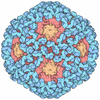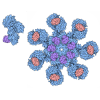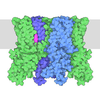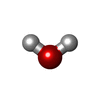+ Open data
Open data
- Basic information
Basic information
| Entry | Database: PDB / ID: 1ycs | ||||||
|---|---|---|---|---|---|---|---|
| Title | P53-53BP2 COMPLEX | ||||||
 Components Components |
| ||||||
 Keywords Keywords | COMPLEX (ANTI-ONCOGENE/ANKYRIN REPEATS) / ANKYRIN REPEATS / SH3 / P53 / TUMOR SUPPRESSOR / MULTIGENE FAMILY / NUCLEAR PROTEIN / PHOSPHORYLATION / DISEASE MUTATION / POLYMORPHISM / COMPLEX (ANTI-ONCOGENE-ANKYRIN REPEATS) / COMPLEX (ANTI-ONCOGENE-ANKYRIN REPEATS) complex | ||||||
| Function / homology |  Function and homology information Function and homology informationnegative regulation of helicase activity / Loss of function of TP53 in cancer due to loss of tetramerization ability / Regulation of TP53 Expression / signal transduction by p53 class mediator / negative regulation of G1 to G0 transition / negative regulation of glucose catabolic process to lactate via pyruvate / Transcriptional activation of cell cycle inhibitor p21 / regulation of intrinsic apoptotic signaling pathway by p53 class mediator / negative regulation of pentose-phosphate shunt / ATP-dependent DNA/DNA annealing activity ...negative regulation of helicase activity / Loss of function of TP53 in cancer due to loss of tetramerization ability / Regulation of TP53 Expression / signal transduction by p53 class mediator / negative regulation of G1 to G0 transition / negative regulation of glucose catabolic process to lactate via pyruvate / Transcriptional activation of cell cycle inhibitor p21 / regulation of intrinsic apoptotic signaling pathway by p53 class mediator / negative regulation of pentose-phosphate shunt / ATP-dependent DNA/DNA annealing activity / Activation of NOXA and translocation to mitochondria / regulation of cell cycle G2/M phase transition / oligodendrocyte apoptotic process / negative regulation of miRNA processing / intrinsic apoptotic signaling pathway in response to hypoxia / regulation of fibroblast apoptotic process / positive regulation of thymocyte apoptotic process / oxidative stress-induced premature senescence / regulation of tissue remodeling / positive regulation of mitochondrial membrane permeability / mRNA transcription / bone marrow development / positive regulation of programmed necrotic cell death / circadian behavior / T cell proliferation involved in immune response / regulation of mitochondrial membrane permeability involved in apoptotic process / germ cell nucleus / RUNX3 regulates CDKN1A transcription / homolactic fermentation / TP53 Regulates Transcription of Death Receptors and Ligands / Activation of PUMA and translocation to mitochondria / TP53 regulates transcription of additional cell cycle genes whose exact role in the p53 pathway remain uncertain / histone deacetylase regulator activity / regulation of DNA damage response, signal transduction by p53 class mediator / negative regulation of glial cell proliferation / Regulation of TP53 Activity through Association with Co-factors / negative regulation of neuroblast proliferation / mitochondrial DNA repair / T cell lineage commitment / Formation of Senescence-Associated Heterochromatin Foci (SAHF) / ER overload response / thymocyte apoptotic process / B cell lineage commitment / TP53 Regulates Transcription of Caspase Activators and Caspases / entrainment of circadian clock by photoperiod / cardiac septum morphogenesis / negative regulation of mitophagy / negative regulation of DNA replication / Zygotic genome activation (ZGA) / Association of TriC/CCT with target proteins during biosynthesis / PI5P Regulates TP53 Acetylation / necroptotic process / TP53 Regulates Transcription of Genes Involved in Cytochrome C Release / positive regulation of release of cytochrome c from mitochondria / negative regulation of telomere maintenance via telomerase / negative regulation of cell cycle / SUMOylation of transcription factors / TP53 regulates transcription of several additional cell death genes whose specific roles in p53-dependent apoptosis remain uncertain / TFIID-class transcription factor complex binding / intrinsic apoptotic signaling pathway by p53 class mediator / rRNA transcription / negative regulation of reactive oxygen species metabolic process / Transcriptional Regulation by VENTX / cellular response to UV-C / replicative senescence / viral process / general transcription initiation factor binding / cellular response to actinomycin D / intrinsic apoptotic signaling pathway in response to endoplasmic reticulum stress / positive regulation of RNA polymerase II transcription preinitiation complex assembly / neuroblast proliferation / intrinsic apoptotic signaling pathway in response to DNA damage by p53 class mediator / positive regulation of execution phase of apoptosis / Pyroptosis / hematopoietic stem cell differentiation / embryonic organ development / NF-kappaB binding / response to X-ray / chromosome organization / type II interferon-mediated signaling pathway / somitogenesis / TP53 Regulates Transcription of Genes Involved in G1 Cell Cycle Arrest / hematopoietic progenitor cell differentiation / glial cell proliferation / negative regulation of fibroblast proliferation / positive regulation of cardiac muscle cell apoptotic process / core promoter sequence-specific DNA binding / negative regulation of stem cell proliferation / cellular response to glucose starvation / mitophagy / cis-regulatory region sequence-specific DNA binding / positive regulation of intrinsic apoptotic signaling pathway / Regulation of TP53 Activity through Acetylation / response to salt stress / 14-3-3 protein binding / mitotic G1 DNA damage checkpoint signaling / gastrulation / negative regulation of proteolysis / cardiac muscle cell apoptotic process / transcription repressor complex Similarity search - Function | ||||||
| Biological species |  Homo sapiens (human) Homo sapiens (human) | ||||||
| Method |  X-RAY DIFFRACTION / X-RAY DIFFRACTION /  SYNCHROTRON / Resolution: 2.2 Å SYNCHROTRON / Resolution: 2.2 Å | ||||||
 Authors Authors | Gorina, S. / Pavletich, N.P. | ||||||
 Citation Citation |  Journal: Science / Year: 1996 Journal: Science / Year: 1996Title: Structure of the p53 tumor suppressor bound to the ankyrin and SH3 domains of 53BP2. Authors: Gorina, S. / Pavletich, N.P. #1:  Journal: Mol.Cell.Biol. / Year: 1996 Journal: Mol.Cell.Biol. / Year: 1996Title: The P53-Binding Protein 53BP2 Also Interacts with Bcl2 and Impedes Cell Cycle Progression at G2/M Authors: Naumovski, L. / Cleary, M.L. #2:  Journal: Proc.Natl.Acad.Sci.USA / Year: 1994 Journal: Proc.Natl.Acad.Sci.USA / Year: 1994Title: Two Cellular Proteins that Bind to Wild-Type But not Mutant P53 Authors: Iwabuchi, K. / Bartel, P.L. / Li, B. / Marraccino, R. / Fields, S. | ||||||
| History |
|
- Structure visualization
Structure visualization
| Structure viewer | Molecule:  Molmil Molmil Jmol/JSmol Jmol/JSmol |
|---|
- Downloads & links
Downloads & links
- Download
Download
| PDBx/mmCIF format |  1ycs.cif.gz 1ycs.cif.gz | 96.6 KB | Display |  PDBx/mmCIF format PDBx/mmCIF format |
|---|---|---|---|---|
| PDB format |  pdb1ycs.ent.gz pdb1ycs.ent.gz | 71.9 KB | Display |  PDB format PDB format |
| PDBx/mmJSON format |  1ycs.json.gz 1ycs.json.gz | Tree view |  PDBx/mmJSON format PDBx/mmJSON format | |
| Others |  Other downloads Other downloads |
-Validation report
| Summary document |  1ycs_validation.pdf.gz 1ycs_validation.pdf.gz | 376.9 KB | Display |  wwPDB validaton report wwPDB validaton report |
|---|---|---|---|---|
| Full document |  1ycs_full_validation.pdf.gz 1ycs_full_validation.pdf.gz | 391.3 KB | Display | |
| Data in XML |  1ycs_validation.xml.gz 1ycs_validation.xml.gz | 10.8 KB | Display | |
| Data in CIF |  1ycs_validation.cif.gz 1ycs_validation.cif.gz | 17.2 KB | Display | |
| Arichive directory |  https://data.pdbj.org/pub/pdb/validation_reports/yc/1ycs https://data.pdbj.org/pub/pdb/validation_reports/yc/1ycs ftp://data.pdbj.org/pub/pdb/validation_reports/yc/1ycs ftp://data.pdbj.org/pub/pdb/validation_reports/yc/1ycs | HTTPS FTP |
-Related structure data
| Similar structure data |
|---|
- Links
Links
- Assembly
Assembly
| Deposited unit | 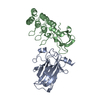
| ||||||||
|---|---|---|---|---|---|---|---|---|---|
| 1 |
| ||||||||
| Unit cell |
|
- Components
Components
| #1: Protein | Mass: 22448.531 Da / Num. of mol.: 1 / Fragment: RESIDUES 97 - 287 Source method: isolated from a genetically manipulated source Source: (gene. exp.)  Homo sapiens (human) / Cell line: BL21 / Gene: RESIDUES 291-529 / Plasmid: PET3D / Gene (production host): RESIDUES 94-292 / Production host: Homo sapiens (human) / Cell line: BL21 / Gene: RESIDUES 291-529 / Plasmid: PET3D / Gene (production host): RESIDUES 94-292 / Production host:  |
|---|---|
| #2: Protein | Mass: 26943.475 Da / Num. of mol.: 1 / Fragment: RESIDUES 327 - 519 Source method: isolated from a genetically manipulated source Source: (gene. exp.)  Homo sapiens (human) Homo sapiens (human)Description: THE FRAGMENT USED IN THE CRYSTALLIZATION (RESIDUES 291-519) WAS PRODUCED BY THE CLEAVAGE OF FACTOR XA FROM GST-FUSION PROTEIN Cell line: BL21 / Gene: RESIDUES 291-529 / Plasmid: PGEX-3X, GST FUSION / Gene (production host): RESIDUES 291-529 / Production host:  |
| #3: Chemical | ChemComp-ZN / |
| #4: Water | ChemComp-HOH / |
-Experimental details
-Experiment
| Experiment | Method:  X-RAY DIFFRACTION X-RAY DIFFRACTION |
|---|
- Sample preparation
Sample preparation
| Crystal | Density Matthews: 3.02 Å3/Da / Density % sol: 59.21 % | ||||||||||||||||||||||||||||||||||||||||||||||||||||||||||||
|---|---|---|---|---|---|---|---|---|---|---|---|---|---|---|---|---|---|---|---|---|---|---|---|---|---|---|---|---|---|---|---|---|---|---|---|---|---|---|---|---|---|---|---|---|---|---|---|---|---|---|---|---|---|---|---|---|---|---|---|---|---|
| Crystal grow | *PLUS Temperature: 4 ℃ / pH: 6.8 / Method: vapor diffusion, hanging drop | ||||||||||||||||||||||||||||||||||||||||||||||||||||||||||||
| Components of the solutions | *PLUS
|
-Data collection
| Diffraction source | Source:  SYNCHROTRON / Site: SYNCHROTRON / Site:  CHESS CHESS  / Beamline: A1 / Wavelength: 0.92 / Beamline: A1 / Wavelength: 0.92 |
|---|---|
| Detector | Detector: CCD / Date: Dec 22, 1995 |
| Radiation | Monochromatic (M) / Laue (L): M / Scattering type: x-ray |
| Radiation wavelength | Wavelength: 0.92 Å / Relative weight: 1 |
| Reflection | Num. obs: 30230 / % possible obs: 99.1 % / Redundancy: 7.3 % / Rmerge(I) obs: 0.057 |
| Reflection | *PLUS Highest resolution: 2.2 Å / Num. measured all: 220654 |
- Processing
Processing
| Software |
| ||||||||||||||||||||||||||||||||||||||||||||||||||||||||||||
|---|---|---|---|---|---|---|---|---|---|---|---|---|---|---|---|---|---|---|---|---|---|---|---|---|---|---|---|---|---|---|---|---|---|---|---|---|---|---|---|---|---|---|---|---|---|---|---|---|---|---|---|---|---|---|---|---|---|---|---|---|---|
| Refinement | Resolution: 2.2→7 Å / σ(F): 2
| ||||||||||||||||||||||||||||||||||||||||||||||||||||||||||||
| Refinement step | Cycle: LAST / Resolution: 2.2→7 Å
| ||||||||||||||||||||||||||||||||||||||||||||||||||||||||||||
| Refine LS restraints |
|
 Movie
Movie Controller
Controller



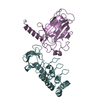

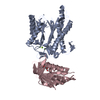
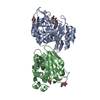
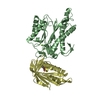
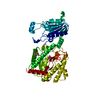
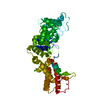
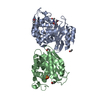
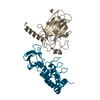
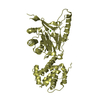
 PDBj
PDBj




